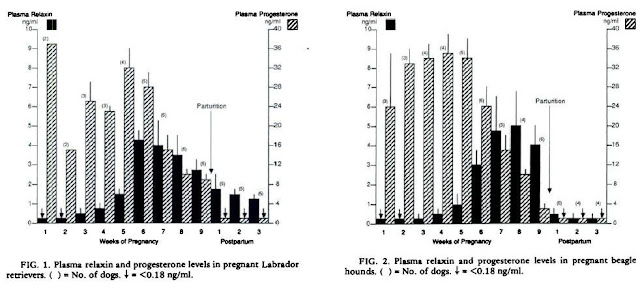Relaxin is a hormone secreted by the corpus luteum and placenta during the later parts of pregnancy. Relaxin has been shown in previous studies to allow more flexability in the pubic ligaments, vagina and cervix by decreasing collagen by stimulating collagenase enzymes. This study was designed to look at the detectable blood concentrations of relaxin, estradiol and progesterone during pregnancy and postpartum in two species of dogs.
Summary of the Article:
Researchers in this study followed weekly relaxin levels in the blood throughout
pregnancy, partuition and lactation in labrador retreivers and beagles. When females were in heat, they were placed with a male and allowed to mate. After copulation, weekly samples of relaxin, progesterone and estradiol concentrations were determined by double antibody radioimmunoassay. Blood
samples from male and female dogs that were not in heat, as well as females that had mated but not conceived (pseudopregnant) were used as controls.
The results in figure 1 and 2 show that in the labrador retreiver relaxin levels begin to increase at 4 weeks
of pregnancy and peak at 6, then slowely decline. After 3 weeks postpartum however, levels are still higher than they were initially. This is in contrast to the levels in the beagle, which peak between 7-8 weeks, but return to initial levels in the following 3 weeks postpartum.
Figure 4 shows the levels of progesterone and estradiol during the study. They show that their patterns of secretion into the blood do not match that of relaxin. Progesterone declined before relaxin did, and estradiol levels were very low toward the end of the pregnancy while relaxin was still higher. Meanwhile Figure 3 shows the following 10 weeks postpartum, during which lactation occurs. The levels of relaxin in the beagle remain low and steadily decrease. The levels of relaxin in the labrador retreiver are much higher initially, but steadily decrease in the remaining weeks.
Finally, figure 5 shows progesterone and relaxin concentration in pseudopregnant dogs.The levels of relaxin in the blood remain undetectable during the 11 weeks they were measured. This shows that relaxin has a role in pregnancy, and is not secreted in response to psychological stimulus, or the act of copulation.
Critique:
- This paper had good evidence suggesting the increase in levels of relaxin toward the middle and end of pregnancy in dogs. It also had good evidence to suggest that estradiol and progesterone and secreted independantly of relaxin. The figure showing pseudopregnancy was effective in showing that this hormone is secreted in response to changes that occur in pregnancy.
- However, in this study, the sample size was very small, as it included only 5 beagles and 8 labrador retreivers, 3 of which did not become pregnant.
- The blood concentrations of relaxin in the labrador retreiver were high after partuition and during lactation, while those of the beagle were not.The biggest problem with this experiment, and perhaps that which distorts alot of the data is the fact that 80% of the labrador retreivers used had hip dysplasia, a condition which possibly involves improperly functioning relaxin. If you are trying to determine normal levels of relaxin during pregnancy, it is not reliable to use a group of animals that possibly have a problem in regulating the hormone in question. Meanwhile, the beagle group which they compare the retrievers to had almost no incidence of hip displasia.
- The authors say the fact that the labrador retreiver has higher base levels of relaxin is possibly related to the hip dysplasia, however to make such a statement, a control group without hip dysplasia would have to have been used. Furthermore, the relaxin antiserum R6, which they used for RIA is well documented in its effect of cross reacting with other relaxin-like peptides. This casts doubts on the identity of the hormone they are measuring after partuition in the labrador retreiver and possibly the entire experiment
The developmental stages of pregnancy in dogs needs to be investigated. In humans, the corpus luteum increases in size by 3x during the sixth week of pregnancy. If this is the case in the dog, this would coincide with the fact that relaxin is secreted by the corpus luteum.
More reliable methods of determining relaxin concentration after lactation are also needed, with a larger sample size.




